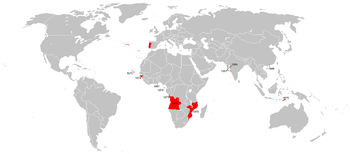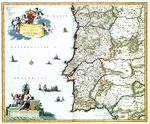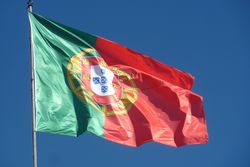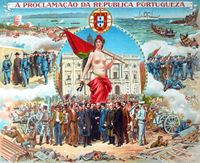الجمهورية البرتغالية الأولى
Portuguese Republic República Portuguesa | |||||||||
|---|---|---|---|---|---|---|---|---|---|
| 1910–1926 | |||||||||
 | |||||||||
| العاصمة | Lisbon | ||||||||
| اللغات الشائعة | Portuguese (in Continental Portugal, Madeira and Azores, official in the Portuguese Empire) | ||||||||
| الحكومة | Dominant-party Parliamentary republic | ||||||||
| President | |||||||||
• 1911–1915 | Manuel de Arriaga (1st) | ||||||||
• 1925–1926 | Bernardino Machado (last) | ||||||||
| Prime Minister | |||||||||
• 1911 | João Pinheiro Chagas (1st) | ||||||||
• 1925–1926 | António Maria da Silva (last) | ||||||||
| التشريع | Congress of the Republic | ||||||||
• Upper house | Senate | ||||||||
• Lower house | Chamber of Deputies | ||||||||
| التاريخ | |||||||||
| October 5, 1910 | |||||||||
| August 21, 1911 | |||||||||
| May 29, 1926 | |||||||||
| Area | |||||||||
| 1911 | 92،391 km2 (35،672 sq mi) | ||||||||
| 1920 | 92،391 km2 (35،672 sq mi) | ||||||||
| التعداد | |||||||||
• 1911 | 5969056 | ||||||||
• 1920 | 6032991 | ||||||||
| Currency | Portuguese real (1910–1911) Portuguese escudo (1911–1926) | ||||||||
| |||||||||
جزء من سلسلة عن |
|---|
| تاريخ البرتغال |
 |
| خط زمني |
The First Portuguese Republic (برتغالية: Primeira República Portuguesa; officially: República Portuguesa, Portuguese Republic) spans a complex 16-year period in the history of Portugal, between the end of the period of constitutional monarchy marked by the 5 October 1910 revolution and the 28 May coup d'état of 1926. The last movement instituted a military dictatorship known as Ditadura Nacional (national dictatorship) that would be followed by the corporatist Estado Novo (new state) regime of António de Oliveira Salazar.
The sixteen years of the First Republic saw nine presidents and 44 ministries, and have been described as consisting of "continual anarchy, government corruption, rioting and pillage, assassinations, arbitrary imprisonment and religious persecution".[1]
في 5 أكتوبر 1910، مع نزول الملك مانويل الثاني عن العرش، تنتهي الملكية في البرتغال. واعلان الجمهورية البرتغالية الأولى. تيوفيلو براگا يصبح أول رئيس للحكومة المؤقتة للبلد.

Sardica, however, also points up the permanent impact of the republican experiment:
- Despite its overall failure, the First Republic endowed twentieth-century Portugal with an insurpassable and enduring legacy—a renewed civil law, the basis for an educational revolution, the principle of separation between State and Church, the overseas empire (only brought to an end in 1975), and a strong symbolic culture whose materializations (the national flag, the national anthem and the naming of streets) nobody has dared to alter and which still define the present-day collective identity of the Portuguese. The Republic’s prime legacy was indeed that of memory.[2]
المراجع
للاستزادة
- Leal, Ernesto Castro. "Parties and political identity: the construction of the party system of the Portuguese Republic (1910-1926)." E-journal of Portuguese History 7#1 (2009): 37-44. Online[dead link]
- Meneses, Filipe Ribeiro De. Afonso Costa (London: Haus Publishing, 2010); 227 pp. excerpt
- Sardica, José Miguel. "The Memory of the Portuguese First Republic throughout the Twentieth Century," E-Journal of Portuguese History (Summer 2011) 9#1 pp 1–27. online
- Wheeler, Douglas L. "The Portuguese revolution of 1910." Journal of Modern History (1972): 172-194. in JSTOR
- Wheeler, Douglas L. Republican Portugal: a political history, 1910-1926 (U of Wisconsin Press, 1999)
- Pages using gadget WikiMiniAtlas
- Articles containing برتغالية-language text
- Pages using infobox country with unknown parameters
- Portal-inline template with redlinked portals
- Pages with empty portal template
- Pages using Lang-xx templates
- Articles with dead external links from January 2017
- Coordinates on Wikidata
- First Portuguese Republic
- Portuguese Republic
- History of Portugal by polity
- دكتاتوريات عسكرية
- Modern Portugal
- Former countries on the Iberian Peninsula
- بلدان سابقة في اوروبا
- جمهوريات سابقة
- Political history of Portugal
- Republicanism in Portugal
- Anti-Catholicism in Portugal
- Anti-clericalism
- دول وأقاليم تأسست في 1910
- States and territories disestablished in 1926
- 1910s in Portugal
- 1920s in Portugal
- 1910 establishments in Portugal
- 1926 disestablishments in Portugal
- 20th century in Portugal


